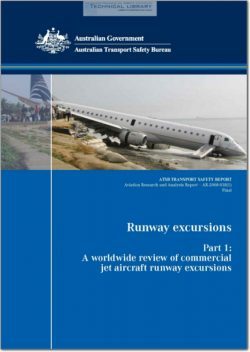ATSB-AR-2008-018

- Version
- 151 Downloads
- 3.13 MB File Size
- 1 File Count
- August 9, 2016 Create Date
- August 9, 2016 Last Updated
Runway Excursions - Part 2; Minimizing the Likelihood and Consequences of Runway Excursions

Runway excursion accidents are not an uncommon occurrence in commercial
aviation. They account for a significant proportion of approach and landing
accidents, and a quarter of all incidents and accidents in air transport (IF ALPA,
2008). Between 1998 and 2007, there were 120 excursion accidents on landing
worldwide. Over the same period, there were three excursions involving Australian-
registered commercial jet aircraft, and two excursions of foreign-registered
commercial jet aircraft in Australia. While this report focuses on commercial jet
aircraft, 425 runway excursions of general aviation and low capacity aircraft were
reported to the ATSB over this 10 year period. Those occurrences involved both
Australian VH—registered aircraft and foreign—registered aircraft operating at
Australian aerodromes.
Despite a continuing downwards trend in commercial aircraft hull loss accidents
over the last decade, approach and landing accidents are one area which has shown
little improvement in safety. The 2008 International Air Transport Association
(IATA) Safety Report has shown that runway excursions were the most frequent
type of accident in 2008, accounting for 25 per cent (IATA, 2009).
In Australia, previous runway excursions have led to little more than minor damage
to the aircraft, with few (if any) injuries to passengers or crew. However, as runway
excursions occur at airports (which are often located in built-up urban areas), a
potential exists for injury to both people on board the aircraft and people who work,
live or travel in close proximity to airports. Several significant runway excursion
accidents occurred worldwide in 2007 and 2008 that resulted in over 300 on—board
and ground fatalities. In 2008, IATA found that over half of all runway excursions
globally in that year resulted in a hull loss, and 15 per cent involved fatalities
(IATA, 2009).
| File | Action |
|---|---|
| ATSB-AR-2008-018 Runway Excursions - Part 2; Minimizing the Likelihood and Consequences of Runway Excursions.pdf | Download |

Comment On This Post